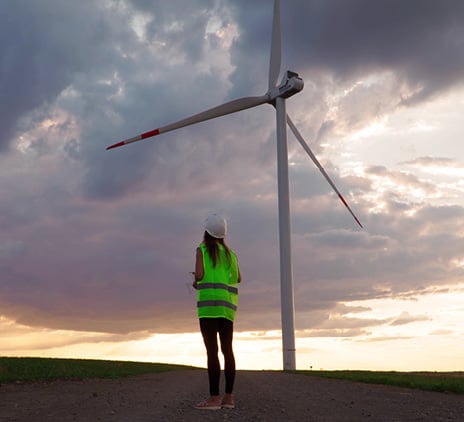-
Financial administration
An accurate financial administration provides you with the information you need to take the right decisions. The big advantage of a digital financial administration is that it provides insight into your most important financial processes at any time, whether this is the invoices, salary payments or bank changes.
-
Financial insight
You want to take the right decisions, based on trustworthy and clear management information. You want to have access to all your financial data, 24/7, in order to determine your position and be able to adjust where necessary.
-
Global compliance partnering
Outsourced compliance services comprises the total financial compliance of your business, in accounting, financial reporting, payroll, legal and various tax reporting obligations. We can make sure you don’t have to worry.

-
Impact House by Grant Thornton
Building sustainability and social impact. That sounds good. But how do you go about it in the complex world of stakeholders, regulations and frameworks and changing demands from clients and society? How do you deal with important issues such as climate change and biodiversity loss?
-
Business risk services
Minimize risk, maximize predictability, and execution Good insights help you look further ahead and adapt faster. Whether you require outsourced or co-procured internal audit services and expertise to address a specific technology, cyber or regulatory challenge, we provide a turnkey and reliable solution.
-
Cyber risk services
What should I be doing first if my data has been kidnapped? Have I taken the right precautions for protecting my data or am I putting too much effort into just one of the risks? And how do I quickly detect intruders on my network? Good questions! We help you to answer these questions.
-
Deal advisory
What will the net proceeds be after the sale? How do I optimise the selling price of my business or the price of one of my business activities?
-
Forensic & integrity services
Do you require a fact finding investigation to help assess irregularities? Is it necessary to ascertain facts for litigation purposes?

-
Auditing of annual accounts
You are answerable to others, such as shareholders and other stakeholders, with regard to your financial affairs. Financial information must therefore be reliable. What is more, you want to know how far you are progressing towards achieving your goals and what risks may apply.
-
IFRS services
Financial reporting in accordance with IFRS is a complex matter. Nowadays, an increasing number of international companies are becoming aware of the rules. But how do you apply them in practice?
-
ISAE & SOC Reporting
Our ISAE & SOC Reporting services provide independent and objective reports on the design, implementation and operational effectiveness of controls at service organizations.
-
Pre-audit services
Pre-audit services is all about making the company’s entire financial administration ready for checking before the external accountant begins his/her audit of the annual accounts.
-
SOx law implementation
The SOx legislation dictates that management is structurally accountable for reporting on the internal control relevant to the financial statements.

-
International corporate tax
The Netherlands’ tax regime is highly dynamic. Rules and the administrative courts raise new challenges in fiscal considerations on a nearly daily basis, both nationally and internationally.
-
VAT advice
VAT is an exceptionally thorny issue, especially in major national and international activities. Filing cross-border returns, registering or making payments requires specialised knowledge. It is crucial to keep that knowledge up-to-date in order to respond to the dynamics of national and international legislation and regulation.
-
Customs
Importing/exporting goods to or from the European Union involves navigating complicated customs formalities. Failure to comply with these requirements usually results in delays. In addition, an excessively high rate of taxation or customs valuation for imports can cost you money.
-
Human Capital Services
Do your employees determine the success and growth of your organisation? And are you in need of specialists which you can ask your Human Resources (HR) related questions? Human Resources (HR) related questions? Our HR specialists will assist you in the areas of personnel and payroll administration, labour law and taxation relating to your personnel. We provide you with high-quality personnel and payroll administration, good HR guidance and the right (international) advice as standard. All this, of course, with a focus on the human dimension.
-
Innovation & grants
Anyone who runs their own business sets themselves apart from the rest. Anyone who dares stick their neck out distinguishes themselves even more. That can be rather lucrative.
-
Tax technology
Driven by tax technology, we help you with your (most important) tax risks. Identify and manage your risks and become in control!
-
Transfer pricing
The increased attention for transfer pricing places greater demands on the internal organisation and on reporting.
-
Sustainable tax
In this rapidly changing world, it is increasingly important to consider environmental impact (in accordance with ESG), instead of limiting considerations to financial incentives. Multinational companies should review and potentially reconsider their tax strategy due to the constantly evolving social standards
-
Pillar Two
On 1 January 2024 the European Union will introduce a new tax law named “Pillar Two”. These new regulations will be applicable to groups with a turnover of more than EUR 750 million.
-
Cryptocurrency and digital assets
In the past decade, the utilization of blockchain and its adoption of a distributed ledger have proven their capacity to revolutionize the financial sector, inspiring numerous initiatives from businesses and entrepreneurs.
-
Streamlined Global Compliance
Large corporations with a presence in multiple jurisdictions face a number of compliance challenges. Not least of these are the varied and complex reporting and compliance requirements imposed by different countries. To overcome these challenges, Grant Thornton provides a solution to streamline the global compliance process by centralizing the delivery approach.
-
Expand into new markets
Do you seek for opportunities in the global business arena? Whether you are about to open a new office in a foreign country or considering an international acquisition, you need certainty of making the right choices for your company. Global expansion isn’t always as simple as it sounds. The good thing is that we’re here to help!
-
Expanding your business in the Netherlands
International expansion is an important step. The Netherlands can be your gateway to Europe for doing business abroad. But why you should choose the Netherlands?
-
Global contacts
Wherever you choose to do business, you want access to people with the best ideas and critical thinking that will enable you to grow your business at home and abroad.
-
Corporate Law
From the general terms and conditions to the legal strategy, these matters need to be watertight. This provides assurance, and therefore peace of mind and room for growth. We will be pro-active and pragmatic in thinking along with you. We always like to look ahead and go the extra mile.
-
Employment Law
Small company or large multinational: in any company your people are of the utmost importance for your business. Employment brings with it many issues in many areas and often has legal consequences. For big strategic, but also for more everyday questions about employment law, our lawyers are ready to help you out. Also for questions about international employment law. Do you have your own HR department? We’ll gladly assist them. We deliver bespoke services and are there when you need us.
-
Sustainable legal
Sustainability is more than a buzzword - it is the core of our legal advice towards sustainable success. From drafting sustainable contracts, integrating sustainable HR policies and ESG due diligence within our M&A practice to advising on ESG and other (national and international) legislation: we prefer to be pragmatic and proactive in helping your business.
-
Maritime sector
How can you continue to be a global leader? The Netherlands depends on innovation. It is our high-quality knowledge which leads the maritime sector to be of world class.


If you are planning to invest in new assets exceeding an amount of 2,800 euro (2025), it is worth to prioritise assets that are environmentally friendly and/or investments that promote energy efficiency and sustainability. By deciding upon sustainable investing, you are not just staying one step ahead in business – you are also unlocking considerable tax benefits through a range of Dutch schemes available for companies that invest in such qualifying assets.
The most recurring investment schemes are the Environmental investment allowance (MIA), Random depreciation of environmental investments (VAMIL), Energy investment allowance (EIA).
Tax facilities
Environmental investment facilities
The Environment Investment Allowance (MIA) and the Random depreciation of environmental investments scheme (VAMIL) are two impactful investment facilities to support your green initiatives. Moreover, the facilities can be applied simultaneously to many qualifying investments.
Environmental investment allowance (MIA)
The MIA offers the opportunity to deduct up to a maximum of 45 percent of the investment from the taxable result. The percentage depends on the environmental effects and the prevalence of the asset. In the most favourable scenario, the financial benefit can amount to 14 percent of the initial investment.
Random depreciation of environmental investments scheme (VAMIL)
The VAMIL is a depreciation facility, applicable to environmentally friendly investments. The facility provides the opportunity to depreciate 75 percent of the investment at any time. This brings an additional advantage of being able to apply the depreciation strategically in (profitable) years of choice. As such, using the facility to the full extent may result in cash flow advantages.
Energy investment allowance (EIA)
Based on Dutch tax legislation, businesses investing in energy-saving or sustainable energy assets can benefit from a tax deduction (EIA) amounting to 40 percent of the investment costs. This deduction is an additional deduction to the standard depreciation scheme applicable in the Netherlands. As a result, the energy costs will be reduced and an average benefit of 10% could be claimed.
Standard investment facilities
Small-scale investment allowance (KIA)
This incentive is designed to support entrepreneurs making smaller investments in business assets accessible to all. If your total investment in a fiscal year falls between 2,800 euro and 392,231 euro (2025), you can deduct a percentage of the investment amount from your taxable result. The exact deduction depends on the total amount invested within the tax year, with the highest benefits applying to investments within a certain range.
Temporary accelerated depreciation (2023)
The temporary accelerated depreciation scheme for 2023 allowed entrepreneurs to write off certain new business assets at an accelerated rate. Under this scheme, up to 50% of the investment can be written off immediately, significantly reducing your taxable result in the year of purchase. This offers immediate tax savings and can improve the company’s cash flow in line with our previous remarks under the VAMIL.
Confluence with other facilities
Besides the sustainable investment schemes, there is also a ‘standard’ small investment allowance available in the Netherlands. A company can opt for this allowance in case they invest in assets for a maximum of 392,231 euro (2025).
Based on Dutch tax legislation, the taxpayer can make use of both the EIA and the small investment allowance or the MIA/VAMIL and the small investment allowance. The MIA/VAMIL can only be combined if the investment falls under certain categories of the “Milieulijst”.
However, it is not permitted to both apply for MIA/VAMIL and EIA for the same asset. It is important to assess what investment scheme is most beneficial in the given circumstances.
The Accelerated Depreciation 2023 scheme creates further tax-saving possibilities. It can be combined with other facilities such as KIA, EIA, and, under certain conditions, the MIA. This combination presents a unique opportunity for entrepreneurs to maximize their tax benefits while contributing to sustainable business practices.
In some cases, strategic use of combinations such as EIA with accelerated depreciation can deliver remarkable financial benefits, especially where certain MIA or VAMIL limitations apply (e.g., for investments in categories C/D/E/G of the Milieulijst).By any means, please note that combining these options requires careful tax coordination, as some schemes may affect one another. By strategically leveraging the rules, you can make the most of your investments.
Timing of reporting investments
It is crucial to bear in mind that the investment must be reported at the competent authority within three months after the investment, in order to be eligible for the MIA or EIA. Missing this deadline results in losing out on significant tax advantages.
Unlock your benefits
Sustainable investments don’t just benefit the community as a whole — they also improve your company’s bottom line value. But deciding upon the right options and optimizing your approach requires expert knowledge and experience.
Our team at Grant Thornton Netherlands specializes in tax-efficient strategies tailored to your needs. Contact us today to ensure you’re taking full advantage of available opportunities and creating a more sustainable future for your business.
If you are interested in these schemes, contact your tax adviser at Grant Thornton in the Netherlands.








